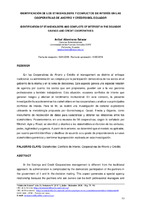Identificación de los stakeholders y conflictos de interés en las cooperativas de ahorro y crédito del Ecuador
Identification of stakeholders and conflicts of interest in the Ecuador Savings and credit cooperatives
Abstract
En las Cooperativas de Ahorro y Crédito el management es distinto al enfoque tradicional, su administración se complica por la participación democrática de los socios en el gobierno de la misma y en la toma de decisiones. Este aspecto genera una especial relación de agencia por cuanto, los socios que son propietarios, pueden ser a la vez gestores profesionales y también trabajadores. Esta situación, ocasiona conflictos de interés que generan riesgos y afectan al rendimiento institucional. En este contexto, la presente investigación busca determinar los stakeholders en las cooperativas y analizar sus principales conflictos de interés. Para tal fin, se realizó una investigación de carácter exploratorio utilizando la metodología propuesta por Gorrochategui, Casali, Frecia y Gigante, como instrumento de recolección de datos para caracterizar y obtener las relaciones entre los stakeholders. Posteriormente, en una muestra de 58 cooperativas, según lo señalado por Mitchell, Agle y Wood, se identificó y clasificó a los stakeholders en función de los atributos, poder, legitimidad y urgencia. A partir de lo anterior, se determinó que el modelo es aplicable, por cuanto permitió identificar y clasificar de acuerdo a su grado de preponderancia a nueve stakeholders genéricos y confirmar la proposición realizada en esta investigación. In the Savings and Credit Cooperatives management is different from the traditional approach, its administration is complicated by the democratic participation of the partners in the government of it and in the decision making. This aspect generates a special agency relationship because the partners who are owners can be both professional managers and workers. This situation causes conflicts of interest that generate risks and affect institutional performance. In this context, this research seeks to determine the stakeholders in the cooperatives and analyze their main conflicts of interest. For this purpose, an exploratory research was carried out using the methodology proposed by Gorrochategui, Casali, Frecia and Gigante, as an instrument for data collection to characterize and obtain the relationships among the stakeholders. Subsequently, in a sample of 58 cooperatives, as indicated by Mitchell, Agle and Wood, stakeholders were identified and classified according to attributes, power, legitimacy and urgency. Based on the above, it was determined that the model is applicable, as it allowed identifying and classifying according to its degree of preponderance to nine generic stakeholders and confirming the proposal made in this research.
Collections
- Revista Visión de Futuro [457]
The following license files are associated with this item:



